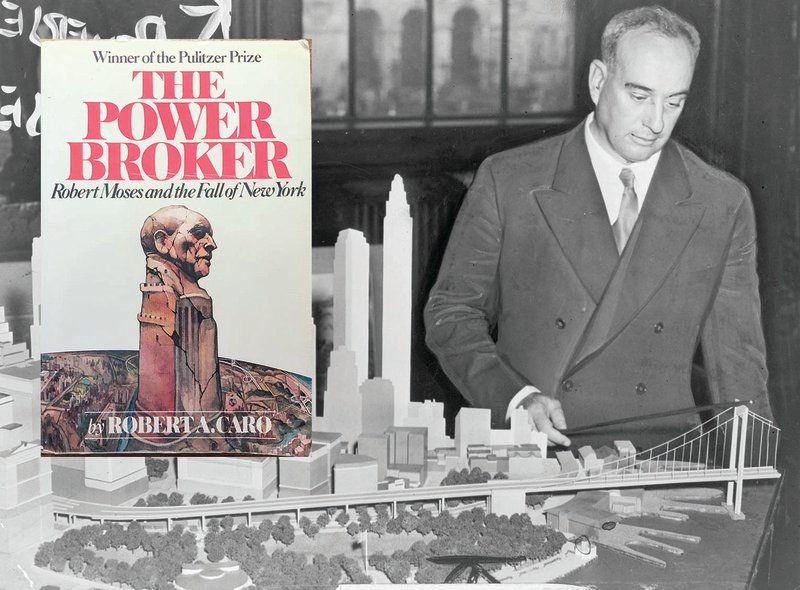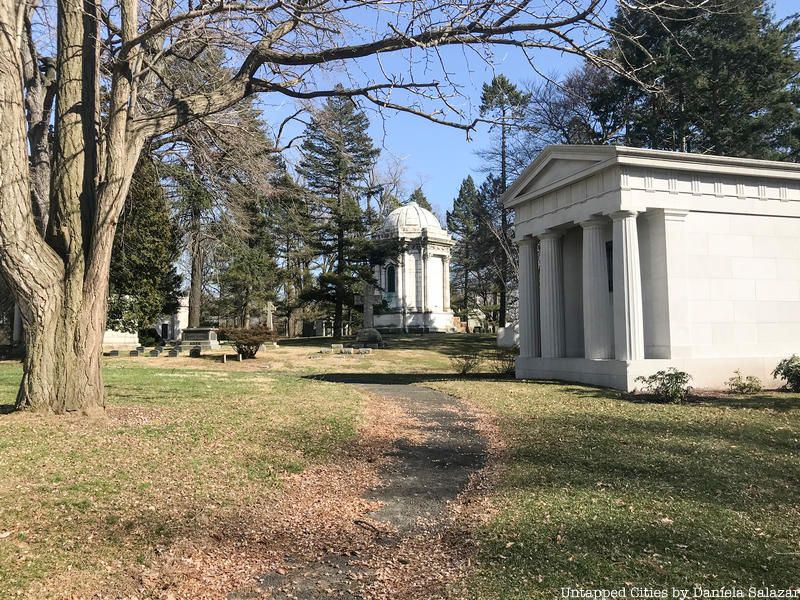Last Chance to Catch NYC's Holiday Notalgia Train
We met the voices of the NYC subway on our nostalgia ride this weekend!



Background photograph from Library of Congress. Book cover photographed by Untapped New York.
The Power Broker, a 1,246 page biography about “master builder” Robert Moses is in the news with the New York Times reporting on all the television interviews the book has appeared in the background during this pandemic. In recent years, Robert Moses has been the subject of numerous cultural productions — a rock musical called BLDZR: The Gospel According to Robert Moses and an opera, and as a character in Motherless Brooklyn (disguised, thinly, as Moses Randolph).
Moses remains a controversial figure, more hated today than loved, often representing the type of urban planning theories that are derided today. His plans to build an expressway through Soho and Little Italy were nixed, but he did manage to get in the Cross-Bronx Expressway, the Sheridan Expressway, the Belt Parkway and more — slicing through neighborhoods or filling in marshland with trash to create more land for highways. Yet there are many things New Yorkers still benefit from that were implemented by Moses: he added more than 22,000 acres of city parkland, built the city’s public pools, brought the United Nations to New York, and more.

The Cross-Bronx Expressway
It’s important to remember that public opinion was quite different earlier when Moses was operating particularly in the earlier portion of his tenure. Caro covers this well in The Power Broker, recounting the rose-colored words used in the news to describe Moses’ projects in his time, including something mundane to us today like the West Side Highway (deemed a “masterpiece” with a “beauty” that was “intoxicating”).
A glowing 1939 article in The Atlantic opens with a truck driver telling his appreciation of Moses’ work on the city’s parks: “This spontaneous tribute is indicative of the growing appreciation of millions of New Yorkers of all ages and classes for the man who, in less than five years, has remade or refurbished a considerable portion of the metropolis. The Commissioner of Parks under Mayor La Guardia’s Fusion administration is also head of the magnificent park system of New York State, which he conceived and largely created.” It goes on and on, calling Moses “the most farsighted and constructive of public spenders,” and that he demonstrates “in brilliant fashion that democracy can be made to work by skillful, resolute handling, and that ‘public improvements’ can be given a surprising amount of beauty.”

A strapping Robert Moses in 1938. (Images via Library of Congress and The Metropolitan Transportation Authority Bridges and Tunnels Special Archives).
Of course, Moses was able to achieve a lot, good and bad, because of his long reign. Moses held onto seemingly unchallenged power in New York for over four decades, through the administrations of 6 mayors, 5 governors, and several presidents. Never elected to office, he was appointed to many positions including a time when he held twelve titles concurrently. These positions included New York City Parks Commissioner, Commissioner of the New York City Planning Commission, Triborough Bridge and Tunnel Authority, President of the New York World’s Fair, New York State Power Authority Chairman President of the, Long Island State Park Commission, and Chairman of the New York State Council of Parks.
How did Moses stay in power for so long? The lowly tollbooth gave Moses a never-ending cash flow that was used as collateral for the bond issues he needed to finance his projects, plus federally subsidized financing for three decades of public works kept the money flowing. He also stealthily rewrote the New York State legislation governing public authorities while he was New York State Governor Al Smith’s chief of staff in the 1920s, laying the groundwork for his consolidation of power later.
You can see the many projects Moses is hated for and appreciated for in our previous coverage, but today we are sharing some of his personal haunts from where he lived, worked, spent time, and where he remains for eternity. We’ve combed through The Power Broker as well as other sources to put together this brief picture of Moses’ intense and long life.
Moses was born and raised in New Haven, Connecticut near Yale University. At the age of nine, his family moved to Manhattan, first living in a townhouse off Fifth Avenue on East 46th Street. As a college student at Yale, Moses would stay with his parents in a rented apartment on Central Park West and 70th Street on visits to New York. According to City Journal, in the early 1930s, Robert Moses lived on Riverside Drive with a view of the massive construction project that would cover the New York Central Rail tracks (now Amtrak) and become a park extension of Riverside Park. (However, we have not been able to corroborate a Riverside Drive residence yet. Caro mentions in The Power Broker however that during this period, Moses lived in a doorman building on Central Park West and would take a cab from City Hall to Riverside Drive on his way home).
In 1939, Moses moved to the Upper East Side. The Atlantic article states, “With their two daughters, [Robert Moses and his wife] live in an apartment on the Upper East Side, overlooking the river, the island parks, and Triborough Bridge.” Caro indicates in The Power Broker that in 1939, Moses was already living on Gracie Terrace. The Atlantic also mentions a house in Babylon, Long Island, taking care to mention that it was simple and old, to reinforce that “Moses’s inheritance helps him to live comfortably, but he is not wealthy, as is commonly supposed, and public service has involved many family sacrifices.” (Clearly this was a “sponsored article” before there was such a thing!
From at least the 1970s to his death, Moses lived at 1 Gracie Terrace, off of East End Avenue on a dead end street that leads out onto the promenade. It’s just a few blocks south of Carl Schurz Park where Gracie Mansion is located. In 2017, the co-op was listed for sale at $1.9 million.

Robert Moses was designated head of the New York City Parks Department and the Triborough Bridge and Tunnel Authority in 1933. By its completion in 1936, the Triborough Bridge connected the Bronx, Manhattan, and Queens via Randall’s and Ward’s Island. A year after the bridge’s finalization came the construction of the Robert Moses Building, which went a bit under the radar.
Originally named “The Administration Building,” the Robert Moses Building was constructed by Aymar Enbury II, who worked on many of Moses’ other architectural projects. The building was completed in 1937 and was meant to be used as the center of operations for the bridge. However, it quickly transformed into a major base of operations for the Triborough Bridge and Tunnel Authority, and its director. The building’s exterior is shown in Motherless Brooklyn as the office of Moses Randall, with the interior scenes shot mostly in the ballroom of the New York Academy of Medicine, with digital backdrops added to make it appear as if it was under the Triborough Bridge.
According to Caro in The Power Broker, Moses also had offices at 80 Centre Street as Chairman of the State Council of Parks, 270 Broadway in the New York State Office Building, an office in Belmont State Park as President of the Long Island State Park Commission, and a “nominal” office at the Arsenal in Central Park, which is still the offices of NYC Parks. Moses also had an office in the Olmsted Building in Flushing Meadows-Corona Park which he used as a temporary office during the 1964-65 World’s Fair where he kept a bed. We also learn in The Power Broker that Moses would sometimes take meetings in his Gracie Terrace apartment, even with the Mayor of New York City, Mayor Lindsay.

In the New York Times obituary, Robert Moses was called a “fine athlete.” He was a member of the swimming team at Yale and even served as the team manager. Caro writes in The Power Broker that the school newspaper doesn’t have a record of Moses winning any competitions but “he was known as a hard worker in practice and a fierce competitor in meets, and he could be counted on for second- or third-place points in either the fifty-yard or the hundred-yard crawl.”
Moses was known to get in after work swim, as recounted by Caro in The Power Broker. Moses would swim anywhere he could — public pools, private pools, and in the ocean. He’d take dips in the tough ocean currents even into his sixties and seventies — out-swimming his younger associates. The opening scenes of Motherless Brooklyn show Moses Randolph finishing a swim at the Asser Levy Public Bath, closed off for his personal use. Another key negotiation scene takes place inside a pool.
Given Moses’ lifelong love for swimming, his zeal for creating public pools is not surprising and remains one of his great legacies. In the 1930s and ’40s, the Department of Parks in New York City was given jurisdiction over city bathhouses and the agency “harnessed Works Progress Administration labor to develop a series of outdoor pools for the city,” describes the New York City Department of Parks & Recreation today. In 1936, eleven pools were opened by Robert Moses, Parks Commissioner, and Mayor Fiorello LaGuardia. In total, Moses oversaw the construction and opening of 23 public pools and bathhouses. Some of the WPA-era pools and accompanying buildings are city landmarks today.

Channeling a little of Moses himself, Governor Andrew Cuomo here crosses in a 1932 Packard car used by FDR as New York State governor
One of the famous fun facts about Robert Moses was that he did not drive himself. As Caro writes in The Power Broker, “Robert Moses had never, aside from a few driving lessons thirty years before, driven a car. He didn’t know what driving was. His chauffeured limousine was an office, to him a particularly pleasant office, in fact, since in it he was away from secretaries and the telephone and in its upholstered confines he could bury himself in work without interruption. Traveling by car had been pleasant for him in the 1920’s; it was still pleasant for him in the 1950’s.”
Caro describes Moses’ black Packard limousine as “the most luxurious Detroit could provide.” One guest described it as “the library of a fine men’s club.” He was able to get an air-conditioned limousine before the mayor of New York City had one. The limo was on call for him 24/7, with three chauffeurs working for Moses personally. Caro writes that this Moses’ limo was the only vehicle that did not have to stop to pay the tolls on the bridges and tunnels. Later, Moses would switch to a Cadillac limo.

Robert Moses died in 1981 at the age of 92 of heart disease. He is buried in Woodlawn Cemetery in an outdoor mausoleum along with his wife Mary. The cemetery writes on its website, that Moses is “ironically entombed in a mausoleum not far from the Major Deegan Expressway.” By all accounts, Moses has been fairly quiet since moving into Woodlawn Cemetery!
Get your copy of The Power Broker to show in your next Zoom interview. And brush up on your Moses knowledge by checking out 5 Things We Can Blame on Robert Moses in NYC and 8 Things We Can Thank Him For!
Additional reporting by Peter Galperin.
Subscribe to our newsletter